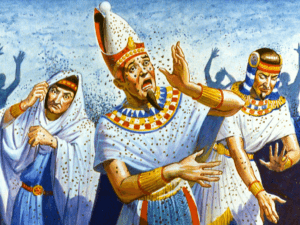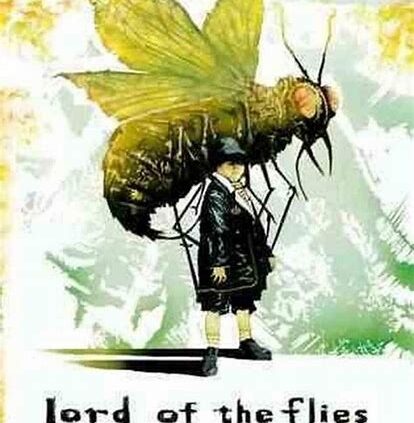The Enemy As Named By Religious Leaders
The Enemy As Named By Religious Leaders
I had intended to complete the consideration of who our enemy is in the last post. But…there are two other names that give us insight into the enemy as named by religious leaders in Jesus’ day. In this post we are going to look at the name Beelzebul (or Beelzebub). In the next post we’ll look at the name Belial.
Religious Leaders Saw The Enemy as Lord of the Flies
This name is applied to Jesus in Matthew 12:24. Here is that verse in context:
 22 Then they brought him a demon-possessed man who was blind and mute, and Jesus healed him, so that he could both talk and see. 23 All the people were astonished and said, “Could this be the Son of David?”
22 Then they brought him a demon-possessed man who was blind and mute, and Jesus healed him, so that he could both talk and see. 23 All the people were astonished and said, “Could this be the Son of David?”
24 But when the Pharisees heard this, they said, “It is only by Beelzebul, the prince of demons, that this fellow drives out demons.”
25 Jesus knew their thoughts and said to them, “Every kingdom divided against itself will be ruined, and every city or household divided against itself will not stand. 26 If Satan drives out Satan, he is divided against himself. How then can his kingdom stand? 27 And if I drive out demons by Beelzebul, by whom do your people drie them out? So then, they will be your judges. 28 But if it is by the Spirit of God that I drive out demons, then the kingdom of God has come upon you.
29 “Or again, how can anyone enter a strong man’s house and carry off his possessions unless he first ties up the strong man? Then he can plunder his house.
The Context and Background
So, the context is a conflict with the religious leaders in Jerusalem. The name means, “Lord of the Flies”. The enemy as named by religious leaders was someone who controlled the flies. It is possible that this name existed ever since the Exodus. Remember the plagues? One of the plagues when the people of Israel were in slavery in Egypt was an abundance of flies. In Egypt, Uatchit was the god of flies. But, as we read in chapter 8 of Exodus, Jehovah, the God of Israel, demonstrated his power over that God by sending swarming flies on the country because the Pharaoh would not free the people from slavery.
Another explanation for this name is below, from a Bible dictionary:
Beelzebub means “lord of the flies.” In Hebrew and Jewish literature, the name is translated to mean “lord of dung” or “lord of filth.” Images of Beelzebub portray him as a fly or flying insect. Scholars have learned that the image of the fly as Beelzebub derives from either the thought that he is a sun god that brings the flies or he is the god invoked to drive flies away from the sacrifice.
We should also note that Beelzebub is the Greek form of the word Baal-zebub. There are strong connections to Baal worship in conjunction with the worship of Beelzebub. Baal was a Canaanite fertility god in the Old Testament. The term zebub means “exalted dwelling.” When we combine those two terms, we have the name “prince of demons.”
The Enemy is Rightly Identified
I can imagine how distracting this was for the Egyptians (this plague was only on the Egyptians, not on the  Israelites). Each August my children and grandchildren all gather at the family cottage on the shores of Lake Michigan. Unfortunately, that time usually coincides with the arrival of flies on the lakeshore. We usually end up moving our chairs from the beach area to the edge of the water to avoid them. Their bites are distracting, to say the least.
Israelites). Each August my children and grandchildren all gather at the family cottage on the shores of Lake Michigan. Unfortunately, that time usually coincides with the arrival of flies on the lakeshore. We usually end up moving our chairs from the beach area to the edge of the water to avoid them. Their bites are distracting, to say the least.
When the enemy as named by religious leaders is identified as Lord of the Flies, it means that the enemy gives pain and distraction.
 He also is the god of filth, excrement and the kinds of things that bring decay and destruction. This is the way William Golding portrayed him in his classic novel, Lord of the Flies. There a group of boys are marooned on an island. Soon order disintegrates and evil prevails. You don’t have to go too far to find examples of this in the world. So, when you preach on spiritual warfare, remember to include a description of the enemy as named by religious leaders of Jesus’ Day.
He also is the god of filth, excrement and the kinds of things that bring decay and destruction. This is the way William Golding portrayed him in his classic novel, Lord of the Flies. There a group of boys are marooned on an island. Soon order disintegrates and evil prevails. You don’t have to go too far to find examples of this in the world. So, when you preach on spiritual warfare, remember to include a description of the enemy as named by religious leaders of Jesus’ Day.



